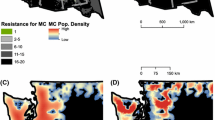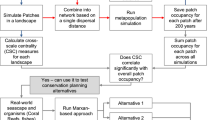Abstract
The methods for measuring landscape connectivity have never been compared or tested for their responses to habitat fragmentation. We simulated movement, mortality and boundary reactions across a wide range of landscape structures to analyze the response of landscape connectivity measures to habitat fragmentation. Landscape connectivity was measured as either dispersal success or search time, based on immigration into all habitat patches in the landscape. Both measures indicated higher connectivity in more fragmented landscapes, a potential for problematic conclusions for conservation plans. We introduce cell immigration as a new measure for landscape connectivity. Cell immigration is the rate of immigration into equal-sized habitat cells in the landscape. It includes both within- and between-patch movement, and shows a negative response to habitat fragmentation. This complies with intuition and existing theoretical work. This method for measuring connectivity is highly robust to reductions in sample size (i.e., number of habitat cells included in the estimate), and we hypothesize that it therefore should be amenable to use in empirical studies. The connectivity measures were weakly correlated to each other and are therefore generally not comparable. We also tested immigration into a single patch as an index of connectivity by comparing it to cell immigration over the landscape. This is essentially a comparison between patch-scale and landscape-scale measurement, and revealed some potential for patch immigration to predict connectivity at the landscape scale. However, this relationship depends on the size of the single patch, the dispersal characteristics of the species, and the amount of habitat in the landscape. We conclude that the response of connectivity measures to habitat fragmentation should be understood before deriving conclusions for conservation management.
Similar content being viewed by others
References
Andreassen, H.P., Ims, R.A. and Stenseth, N.C. 1996. Discontinuous habitat corridors: Effects on male root vole movements. J Appl Ecol 33: 555–560.
Baars, M.A. 1979. Patterns of movement of radioactive carabid beetles. Oecologia 44: 125–140.
Charrier, S., Petit, S. and Burel, F. 1997. Movements of Abax parallelepipedus (Coleoptera, Carabidae) in woody habitats of a hedgerow network landscape: a radio-tracing study. Agr Eco Enviro 61: 133–144.
Collins, R.J. and Barrett, G.W. 1997. Effects of habitat fragmentation on meadow vole (Microtus pennsylvanicus) population dynamics in experiment landscape patches. Lands Ecol 12: 63–76.
Demers, M.N., Simpson, J.W., Boerner, R.E.J., Silva, A., Berns, L. and Artigas, F. (1995). Fencerows, edges, and implications of changing connectivity illustrated by two contiguous Ohio landscapes. Cons Biol 9: 1159–1168.
Diffendorfer, J.E., Gaines, M.S. and Holt, R.D. 1995. Habitat fragmentation and movements of three small mammals (Sigmon, Microtus, and Peromyscus). Ecology 76: 827–839.
Doak, D.F., Marino, P.C. and Kareiva, P.M. 1992. Spatial scale mediates the influence of habitat fragmentation on dispersal success: implications for conservation. Theor Pop Biol 41: 315–336.
Fahrig, L. 1997. Relative effects of habitat loss and fragmentation on population extinction. J Wildl Manag 61: 603–610.
Fahrig, L. 1998. When does fragmentation of breeding habitat affect population survival? Ecol Model 105: 273–292.
Frampton, G.K., Cilgi, T., Fry, G.L.A. and Wratten, S.D. 1995. Effects of grassy banks on the dispersal of some carabid beetles (Coleoptera: Carabidae) on farmland. Biol Cons 71: 347–355.
Gaines, M.S. and McGlenaghan, L.R. 1980. Dispersal in small mammals. Ann Rev Ecol Syst 11: 163–196.
Gardner, R.H., Milne, B.T., Turner, M.G. and O'Neill, R.V. 1987. Neutral models for the analysis of broad-scale landscape pattern. Lands Ecol 1: 19–28.
Goodwin, B.J. and Fahrig L. 1998. Spatial scaling and animal population dynamics. In Ecological Scale: Theory and Application. pp. 193–206. Edited by D. Peterson and V.T. Parker Columbia University Press, New York, NY.
Green, D.G. 1994. Connectivity and complexity in landscapes and ecosystems. Pac Conserv Biol 1: 194–200.
Hansson, L. 1991. Dispersal and connectivity in metapopulations. Biol J Linn Soc 42: 89–103.
Henein, K. and Merriam, G. 1990. The elements of connectivity where corridor quality is variable. Lands Ecol 4: 157–170.
Holmquist, J.G. 1998. Permeabilities of patch boundaries to benthic invertebrates-influences of boundary contrast, light level, and faunal density and mobility. Oikos 81: 558–566.
Keitt, T.H., Urban, D.L. and Milne, B.T. 1997. Detecting critical scales in fragmented landscapes. Conserv. Ecol. [online]1: 4. Available from the Internet. URL: http://www.consecol.org/vol1/iss1/art4
Krohne, D.T. and Burgin, A.B. 1987. Relative success of residents and immigrants in Peromyscus leucopus. Holarctic Ecol 10: 196–200.
Krohne, D.T. and Dubbs, B.A. 1984. An analysis of dispersal in an unmanipulated population of Peromyscus leucopus. Am Midl Nat 112: 146–156.
Krohne, D.T. and Miner, M.S. 1985. Removal trapping studies of dispersal in Peromyscus leucopus. Can Zool J 63: 71–75.
Lidicker, W.Z. 1975. The role of dispersal in the demography of small mammals. In Small mammals: their productivity and population dynamics. pp. 103–128. Edited by F.B. Golley, et al. Cambridge University Press, Cambridge.
Mader, H.J. 1984. Animal habitat isolation by roads and agricultural fields. Biol Conserv 29: 81–96.
Mader, H.J., Schell, C. and Kornacker, P. 1990. Linear barriers to arthropod movements in the landscape. Biol Cons 54: 209–222.
Matter, S.F. 1996. Interpatch movement of the red milkweed beetle, Tetraopes tetraophthalmus: Individual responses to patch size and isolation. Oecologia 105: 447–453.
McGarigal, K. and Marks, B.J. 1995. Fragstats: spatial pattern analysis program for quantifying landscape structure. U. S. Forest Service General Technical Report PNW 351.
Merriam, G., Kozakiewicz, M., Tsuchiya, E. and Hawley, K. 1989. Barriers as boundaries for metapopulations and demes of Peromyscus leucopus in farm landscapes. Lands Ecol 2: 227–235.
Metzger, J.P. and Décamps, H. 1997. The structural connectivity threshold: an hypothesis in conservation biology at the landscape scale. Acta Ecol 18: 1–12.
Petit, S. and Burel, F. 1998a. Connectivity in fragmented populations–Abax parallelepipedus in a hedgerow network landscape. Comptes Rendus de l' Academie des Sciences Serie III–Sciences de la vie–life Sciences 321: 55–61.
Petit, S. and Burel, F. 1998b. Effects of landscape dynamics on the metapopulation of a ground beetle (Coleoptera, Carabidae) in a hedgerow network. Agr Ecol Environ 69: 243–252.
Pither, J. and Taylor, P.D. 1998. An experimental assessment of landscape connectivity. Oikos 83: 166–174.
Poole, K.G. 1997. Dispersal patterns of lynx in the northwest territories. J Wildl Manag 61: 497–505.
Rijnsdorp, A.D. 1980. Pattern of movement in and dispersal from a Dutch forest of Carabus problematicus Hbst. (Coleoptera, Carabidae). Oecologia 45: 274–281.
Ruckelshaus, M., Hartway, C. and Kareiva, P.M. 1997. Assessing the data requirements of spatially explicit dispersal models. Conserv Biol 11: 1298–1306.
Sakai, H.F. and Noon, B.R. 1997. Between-habitat movement of dusky-footed woodrats and vulnerability to predation. J Wildl Manag 61: 343–350.
Schippers, P., Verboom, J., Knaapen, P. and van Apeldoorn, R.C. 1996. Dispersal and habitat connectivity in complex heterogeneous landscapes: An analysis with a GIS-based random walk model. Ecography 19: 97–106.
Schumaker, N.H. 1996. Using landscape indices to predict habitat connectivity. Ecology 77: 1210–1225.
StatSoft, Inc. 1995. STATISTICA for Windows [Computer program manual]. Tulsa, OK.
Taylor, P.D., Fahrig, L., Henein, K. and Merriam, G. 1993. Connectivity is a vital element of landscape structure. Oikos 68: 571–572.
Tischendorf, L. 1997. Modeling individual movements in heterogeneous landscapes: potentials of a new approach. EcolModel 103: 33–42.
Tischendorf, L. and Fahrig, L. On the usage and measurement of landscape connectivity. Oikos, in press.
Wallin, H. and Ekbom, B.S. 1988. Movements of carabid beetles (Coleoptera Carabidae) inhabiting cereal fields: A field tracing study. Oecologia 77: 39–43.
Wiens, J.A., Schooley, R.L. and Weeks, R.D. 1997. Patchy landscapes and animal movements: Do beetles percolate? Oikos 78: 257–264.
With, K.A. 1997. The application of neutral landscape models in conservation biology. Cons Biol 11: 1069–1080.
With, K.A., Gardner, R.H. and Turner, M.G. 1997. Landscape connectivity and population distributions in heterogeneous environments. Oikos 78: 151–169.
With, K.A. and King, A.W. 1997. The use and misuse of neutral landscape models in ecology. Oikos 79: 219–229.
Author information
Authors and Affiliations
Rights and permissions
About this article
Cite this article
Tischendorf, L., Fahrig, L. How should we measure landscape connectivity?. Landscape Ecology 15, 633–641 (2000). https://doi.org/10.1023/A:1008177324187
Issue Date:
DOI: https://doi.org/10.1023/A:1008177324187




